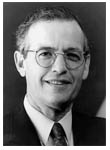|
March 7, 2001: President's Page
A decade ago we celebrated the centennial of The Art Museum, one of Princeton’s most resources. The museum’s founding principle is to give our students access to original works of art, and over the last century, thanks in good measure to donations from alumni and friends, it has become one of the outstanding university museums in the country and one of the richest cultural resources in the region. The museum’s holdings extend from antiquity to the modern day and include Western and non-Western art, painting, sculpture and works on paper. It has gained particular renown for its pre-Columbian and photography collections, its Old Master paintings and drawings, and its Asian holdings. Susan Taylor, the new
Director of The Art Museum, came to Princeton last summer after
twelve years as director and chief curator of the Davis Museum and
Cultural Center at Wellesley College. She is strongly committed
to the teaching mission of Princeton’s museum and has been
actively fostering collaboration with faculty and students. The
museum has always served as an important resource for doctoral students,
especially in the humanities, and has played a fundamental role
in certain undergraduate courses, especially in Art and Archaeology.
For example, student comments on “The History of Art”
(Art 101) inevitably point to precepts in The Art Museum as a compelling
reason to take the course. This fall Professor Peter Bunnell’s
History of Photography course included several art museum exhibitions
as an integral part of the curriculum. Susan Taylor wants to foster
such relationships between the museum and our academic programs.
The museum also presents
exhibitions not connected to specific courses that reflect the interests
of faculty, students and curators. For example, in collaboration
with faculty in the School of Architecture, the museum organized
an exhibition entitled, “Le Corbusier at Princeton: 14-16 November
1935” that opened this February and runs through June 17, 2001.
The exhibition focuses on two drawings executed by Le Corbusier
in conjunction with a series of lectures he gave at Princeton in
1935. Assistant Professor of Architecture, Jesse A. Rieser, designed
the installation; Professor of Architecture, Beatriz Colomina, worked
with the museum to create didactic materials that present Le Corbusier’s
drawings in context, and Princeton architecture students designed
and built the models included in the exhibition. The museum is making
the exhibition the centerpiece for a number of lectures and gallery
talks by experts in the field of architecture, thus using it to
best educational advantage. In the future, the museum also hopes
to increase the number of exhibitions that present or showcase new
scholarship and research. The education and teaching
mission of the museum also extends to the approximately 100,000
visitors the museum welcomes annually. The museum is open to the
public and it takes seriously its responsibility to create strong
ties to the surrounding communities. Indeed, the museum’s staff
is taking steps to provide better information to the public about
where the museum is located, not only geographically—where
it is found on campus—but also in terms of the art experience
it can offer. Making the museum more
approachable means enhancing the museum experience and making the
collections both more accessible and more directly related to a
broad education mission the museum hopes to fulfill. Specific strategies
for achieving these objectives range from enhancing gallery handouts,
to providing explanatory wall texts and extended labels for works,
to reviewing the organization of museum space—what visitors
encounter when they first walk into the museum. An education curator
with special responsibility for strengthening outreach and training
is being added to the staff and a new, more accessible website is
being planned. The overall goal is to give the visitor a museum
experience that results in maximum learning and an intimate connection
to the objects and collections the museum houses. In addition to pursuing
these ambitious educational objectives, Susan Taylor is seeking
to take better advantage of the existing permanent collection, for
instance by creating a collection handbook, by featuring representative
works in special focus exhibitions, and by developing a computerized
collections database system with digitized images that can be made
available to both scholars and the general public through the Web.
In considering areas for expansion, contemporary art will receive
close attention, in part because discussion about the interpretation
of contemporary issues and culture through contemporary art is one
of the most effective ways to engage students and other audiences.
This brief description of Ms. Taylor’s objectives for the museum cannot enumerate all of the programs she has planned. Nor can it capture her infectious energy and sense of possibility. Under her leadership I believe we will see exciting new things happening at the museum, particularly in programming and in the development of new relationships with students, faculty, and alumni, as well as with the museum’s constituencies beyond campus. At the end of a recent presentation she gave to the Council of the Princeton University Community about her plans for the museum, one undergraduate, a Woodrow Wilson School concentrator, thanked her for the programs she has already put into place, in particular, a Friday night jazz series in the museum featuring a student group, Ellipsis Jazz Project. Such programs are bringing students to the museum who might not otherwise think of visiting. It is a sign that her efforts to bring the museum closer to the heart of the intellectual and social life of the University as well as the community are even now succeeding. I urge you to visit the museum the next time you are on campus.
|

 A
Teaching Museum
A
Teaching Museum